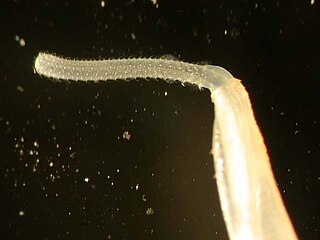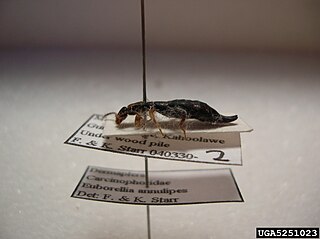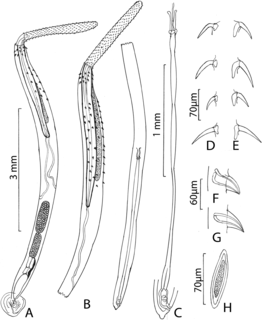
Palaeacanthocephala is a class within the phylum Acanthocephala. The adults of these parasitic platyzoans feed mainly on fish, aquatic birds and mammals. This order is characterized by the presence of lateral longitudinal lacunar canals and a double-walled proboscis receptacle. The nuclei of the hypodermis are fragmented and the males have two to seven cement glands, unlike their relatives the Archiacanthocephala which always have eight.
Cyclostremellini is a minor tribe, a taxonomic grouping, of minute sea snails, marine gastropod mollusks or micromollusks, in the family Pyramidellidae, the pyrams and their allies.

Anisolabididae is a family of earwigs, in the suborder Forficulina and the order Dermaptera. It is one of nine families in the suborder Forficulina, and contains thirty-eight genera spread across thirteen subfamilies.
Gigantorhynchida is an order containing a single family, Gigantorhynchidae of parasitic worms that attach themselves to the intestinal wall of terrestrial vertebrates. Gigantorhynchida contains the following two genera:

Oligacanthorhynchida is an order containing a single parasitic worm family, Oligacanthorhynchidae, that attach themselves to the intestinal wall of terrestrial vertebrates.
Centrorhynchidae is a family of parasitic worms. Three species of these thorny-headed worms in the genus Centrorhynchus were found to parasitize birds of prey and owls Slovakia. These hosts include Buteo buteo, Buteo rufinus, Falco tinnunculus, Asio otus, Strix aluco, Strix uralensis and Tyto alba.

Echinorhynchida is an order of parasitic worms in the phylum Acanthocephala. It contains the following families:

Cavisomidae are a family of parasitic worms from the order Echinorhynchida.
Diplosentidae is a family of parasitic worms from the order Echinorhynchida.
Heteracanthocephalidae is a family of parasitic worms from the order Echinorhynchida.

Illiosentidae is a family of parasitic worms from the order Echinorhynchida.
Tenuisentidae is a family of parasitic spiny-headed worms. The family contains two genera, each with one species.

Rhadinorhynchidae is a family of parasitic worms from the order Echinorhynchida.
Plagiorhynchidae is a family of parasitic Acanthocephalan worms.

Gemmula monilifera is a species of sea snail, a marine gastropod mollusk in the family Turridae, the turrids.
The New Ireland forest rat is a large rodent in the family Muridae. It is endemic to New Ireland, in the Bismarck Archipelago, Papua New Guinea.

Reticulariaceae is a family of slime molds recognized by the Integrated Taxonomic Information System and is composed of the genera Dictydiaethalium, Enteridium, Lycogala, Reticularia, and Tubifera.
Thyreus ceylonicus is a species of bee belonging to the family Apidae in subfamily Apinae. The subspecies are:

Transvenidae is a family of parasitic spiny-headed worms in the order Echinorhynchida. This family contains three species divided into two genera.

Notiosoricini, whose members are known as the North American gray shrews, is a tribe of shrews in the family Soricidae, including the genera Megasorex and Notiosorex. They are found across the southwestern United States and most of Mexico.










